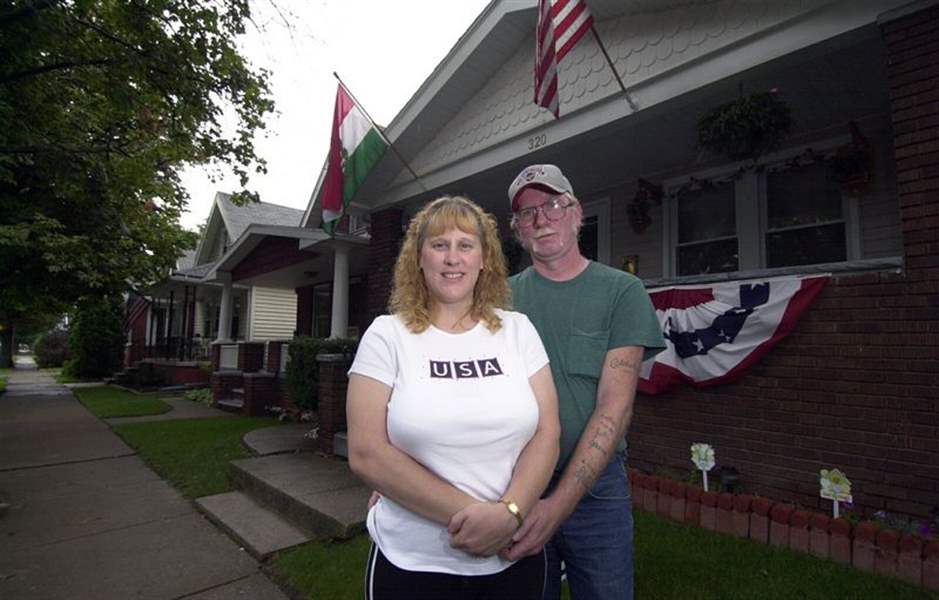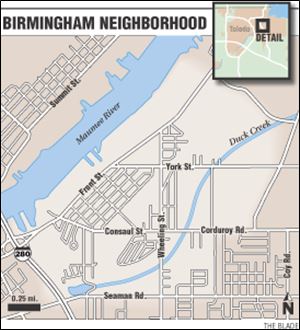
Toledo: Rehabs re-beautifying East Toledo
8/26/2004
Sherry Shabnow and her fiance, Dave Yates, show off their rehabilitated home at 320 Burger St. in the Birmingham district.
Morrison / Blade photo

Rather than wishing they lived in a cleaner neighborhood, Howard and Diana Loughner decided to make it a cleaner neighborhood.
Every day for the last four years, the 47-year-old entrepreneurs have been beautifying East Toledo - with a special focus on Toledo's ethnic neighborhood of Birmingham, which they call home - by filling their red, rusty pickup truck with trash. And they're making a quick buck while they're at it.
"Some days are better than others," Mr. Loughner said, adding that his business, dubbed Diana and Howard's Clean-Up Service, makes anywhere from $20 to $100 a day after he sells some of the trash to scrap metal companies.
"It keeps me and my wife happy," he said, leaning against his truck packed tight with twisted metal, rusted copper wire, and other discarded junk. "It's my way of life."
And the Loughners aren't alone in their quest to beautify the old, historic Birmingham neighborhood rich with ethnic diversity and traditions.

Sherry Shabnow and her fiance, Dave Yates, show off their rehabilitated home at 320 Burger St. in the Birmingham district.
Mary Ellen Poturalski, associate director at River East Economic Revitalization Corp., said members of the Housing East Redevelopment Corp. have been working with volunteers to revitalize Birmingham by rehabilitating older homes.
The two community development corporations are agencies that get grant money and donations to help redevelop deteriorating neighborhoods.
Because the rehabilitation process takes between six to 10 months, volunteers work to restore one a year. Three years ago, they renovated 320 Burger St., a place where Sherry Shabnow, who is proud of her Hungarian heritage, calls home.
"They did everything," she said, listing new walls, plumbing, carpeting, and a bathroom added onto the back of the house, which she bought for $67,000.
"The key to rebuilding neighborhoods and bringing people back that want to live in the city limits is rehabbing houses. You can't keep tearing down," Ms. Poturalski said. "Housing East takes the worst house on the block, rehabs it, and when you finish, it's the best house on the block."
She said improving these homes creates a domino effect - neighbors see how nice the homes in their neighborhood look and start restoring their own.
"You see how it brings the property values out and people want to invest because they're not living next to a rat trap," Ms. Poturalski said.
To help pay for the rehabilitation costs, Housing East has been getting proceeds from the Birmingham Ethnic Festival for the last few years, said Cathy Mott, 49, president of the Birmingham Neighborhood Coalition and a lifelong East Toledo resident of Hungarian heritage.
Mrs. Mott said she supports efforts to restore the neighborhood because she wants to preserve the history of the community.
Birmingham developed as an ethnic neighborhood in the early 1890s when the National Malleable Castings Co. transferred a number of Hungarian workers from its home plant in Cleveland to the new East Toledo site to work at the thriving steel, copper, and shipbuilding industries, according to John Ahern, former director of the Birmingham Cultural Center.
Mr. Ahern said residents participated in two events that revived the sense of community in Birmingham: saving the Birmingham branch of the Toledo-Lucas County Library and protesting the plan to widen Consaul Street to build an overpass that would split Birmingham in half.
Because of these successes, the Birmingham branch of the library doubled in size in December with a substantial addition to the building, and the neighborhood remained undivided, which preserved the sense of community for about 5,000 residents, 40 percent of which are Hungarian, Mrs. Mott said.
"The one thing about this neighborhood that is probably unlike other neighborhoods in the city is there is a cohesiveness unlike anywhere else," she said. "There's a sense of responsibility with a lot of the people here that you don't see with too many of the neighborhoods anymore."
Zauzi Travis, 55, who lives on Valentine Street and is proud of her German heritage, said she personally feels responsible for the cleanliness of the neighborhood, which is why she's been involved in springtime cleanup efforts in Birmingham for the last eight years.
She said she and several other volunteers rent a garbage truck for a day from the Neighborhood Improvement Foundation of Toledo Inc. once or twice a year and follow it for blocks, picking up trash as they go. But she's not satisfied with only being a Good Samaritan twice a year.
"We all individually just pick up all the time," she said. "If there's something in the street, we just open the car door and get it in the car."
Rob Horvath, co-owner of Tony Packo's Restaurant, said he supports those who pick up large amounts of garbage twice a year but thinks that's "the equivalent of taking a garden hose to a three-alarm fire."
He believes the neighborhood's bigger problems are the empty, deteriorating commercial buildings and the shabby, unkept houses owned by landlords with uncut grass, shingles falling off the roof, and cracked sidewalks.
"The neighborhood is not improving," Mr. Horvath said. "If anything, it's getting worse. There's rental house after rental house not being tended to by landlords. They are being ignored, and it's turning into blight around here."
Raymond Zak, 49, president and co-founder of Tee Tops of Toledo Inc., who is half Hungarian and half Czechoslovakian, agrees the neighborhood needs some help but believes there is light at the end of the tunnel.
"I think the neighborhood has hit rock bottom but is starting to come back," he said, citing expanding businesses such as his own as evidence.
Judy Balogh, 80, a Hungarian-American who leads an embroidery club in Birmingham, said looking at the renovated homes and the I-280 construction around the neighborhood shows promise the neighborhood is improving.
"It seems that the neighborhood is going to change a lot for the better, hopefully," she said. "I can see a great future for Birmingham."